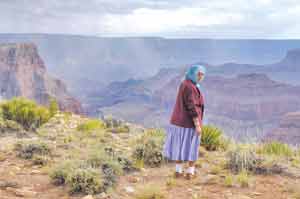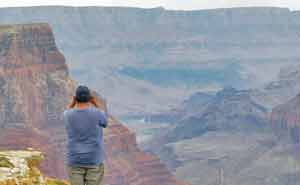Planned western resort may be on protected land
By Cindy Yurth
Tséyi' Bureau
TUBA CITY, March 22, 2012



(File photo - Donovan Quintero)
TOP: The place where the Little Colorado River meets the Colorado River, called the Confluence, is considered sacred by local residents.
SECOND FROM TOP: Mary Ann Nockaideneh, who grew up and raised her family near the Confluence, where the Little Colorado River meets the Colorado River, looks out at the Grand Canyon.
BOTTOM: A man looks at the Grand Canyon with binoculars from the cliff above the Confluence.
"The only place I can see for them to build on the canyon floor and be on Navajo Nation land, you couldn't even see the confluence from there," said Grand Canyon National Park Superintendent Dave Ubueraga. "It would be at least a quarter-mile walk."
Asked whether the National Park Service would allow the development within the park boundaries, Ubueraga replied, "That's some of the most remote and pristine land in the park. Until it's declared wilderness, we have to manage it as such. We're charged with maintaining its solitude and wilderness value."
In other words?
"There would be no development, from our perspective," he confirmed.
Jan Balsom, the park's deputy chief for science and resource management, added that at least two tribes besides the Navajo hold the area sacred and would have to be consulted.
The development could be moved upstream on the Little Colorado, which is exclusively Navajo land, but the tribe would have to convince the feds that the construction and subsequent influx of tourists would have no effect on the spawning grounds of the humpback chub, an endangered indigenous species, said Martha Hahn, chief for science and resource management.
A Scottsdale, Ariz., development group met with Navajo Nation officials Monday to continue talks on the proposed destination resort, tentatively called the "Grand Canyon Escalade."
According to members of an opposition group who said they were allowed to briefly review the plan, it would include buildings both on the canyon rim and the canyon floor, with a one-and-a-quarter-mile tramway connecting the two parts.
A memorandum of understanding signed between the tribe and Confluence Partners LLC last month states the project would require the withdrawal of 5,167 acres of Navajo Nation land, 3,130 of which would be above the rim and the rest below.
Arizona State Rep. Albert Hale, D-St. Michaels, who signed the MOU on behalf of Confluence Partners, did not return a phone call by press time to confirm the scope of the plan.
The opposition group members said they were not allowed to keep, photocopy or photograph the plans they saw, and were asked to leave the meeting when representatives of the Navajo Nation government showed up.
The four members of People of the Confluence, a group of residents and grazing permit holders who oppose the development, said the renderings they saw Monday at the office of Fulcrum Group LLC (whose principal, Lamar Whitmer, is also a member of Confluence Partners) included a restaurant and amphitheater on the floor of the canyon, a hotel and second restaurant on the canyon rim, a museum/art center, two large parking lots and housing for workers, in addition to the tram.
The MOU - which was not released to the press until Tuesday, after the Navajo Times delivered a formal request for it on March 13 - also mentions the possibility of other hotels, an RV park, commercial retail space and an airport.
At peak development, according to a recent written statement from Shelly's office, the resort would employ 2,000 people in an area desperately in need of jobs.
About 90 people attended a meeting in Tuba City Saturday to pose questions about the development to President Ben Shelly's advisor Deswood Tome.
Of the 30 people who spoke, the vast majority were opposed to either any development at the confluence or this particular development - although Bodaway resident Betty Tsinigine, mother of Council Delegate Duane Tsinigine, said they represented just two extended families.
Most of the opponents fall into one or both of two camps: those who feel development would harm people and deities living in the sacred area where the two rivers merge; and those who want development but feel locals have been edged out of the current plans.
Bianica Yellowhair, a recent University of Utah graduate who holds a home-site lease near the confluence, read a prepared statement on behalf of People of the Confluence stating that the rim above the confluence contains many traditional prayer sites and is home to both significant deities and medicinal plants, including "a field of white flowers ... which is used to heal the eye."
Yellowhair said Confluence Partners principal Lamar Whitmer had approached the locals about the development last year, and had alienated people by trying to rush them into signing off on the project.
Afterward, the residents researched the Whitmer and his consulting company, The Fulcrum Group LLC, and discovered he had been indicted for allegedly paying himself $40,000 in unauthorized per diem expenses as head of the Maricopa County Sports Authority in 1993.
He was later acquitted, but "this information raised red flags for my family when considering the business proposal," Yellowhair said.
Ty Tsosie, who said he grew up in the area, admonished the government representatives, saying, "You would feel somehow if somebody goes into your backyard without your permission and sets up shop."
Others questioned whether the Navajo Nation would use eminent domain to claim the land if the locals continued to protest.
Tome quelled that notion, stating, "There's no eminent domain. Nobody's talking about that."
He also said the project was "not even started" and that the tribe is under no compunction to deal with the Confluence Partners although it had signed a memorandum of understanding with the firm to study the feasibility of the project.
Tome also said there was "no secret about the MOU" although he had not sent either the Navajo Times or People of the Confluence a copy at that point in spite of repeated requests.
"President Shelly has been very candid, very open about this," Tome said.
Raymond Maxx of the Navajo-Hopi Land Commission reiterated Tome's promise that eminent domain would not be used and noted that the MOU is still "going through the SAS (signature) process."
He said that if the project is approved, it would still have to go through the Department of Wildlife, the Historic Preservation Department, the Council's Resources Committee and the BIA.
Delegate Tsinigine said that, although he personally was in favor of the development, he would represent the majority of his constituents in the matter.
"If the people say no, so be it," he told the crowd. "But we have to explain it to our children, to the people with master's and doctorate degrees who would be running it."

